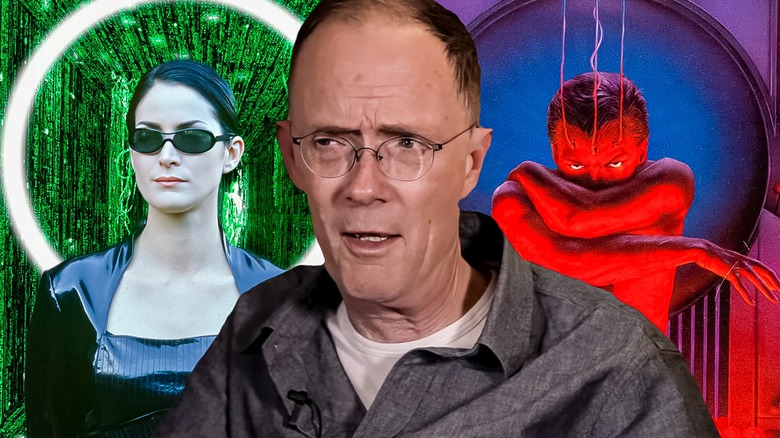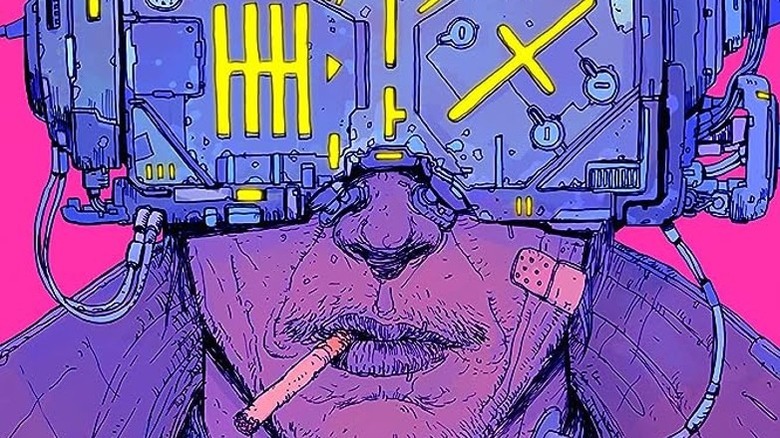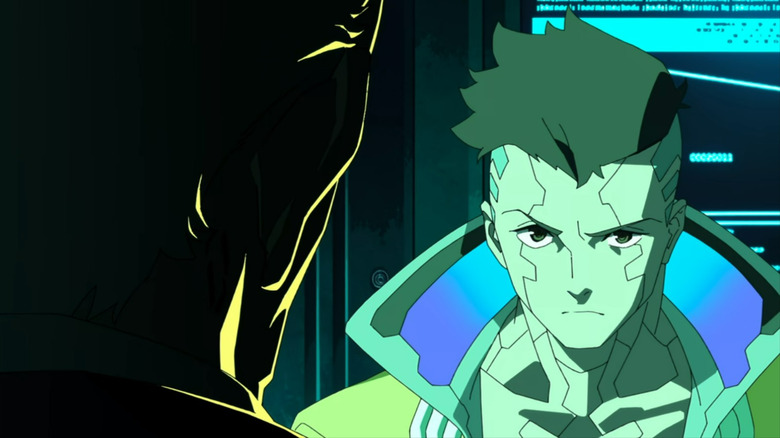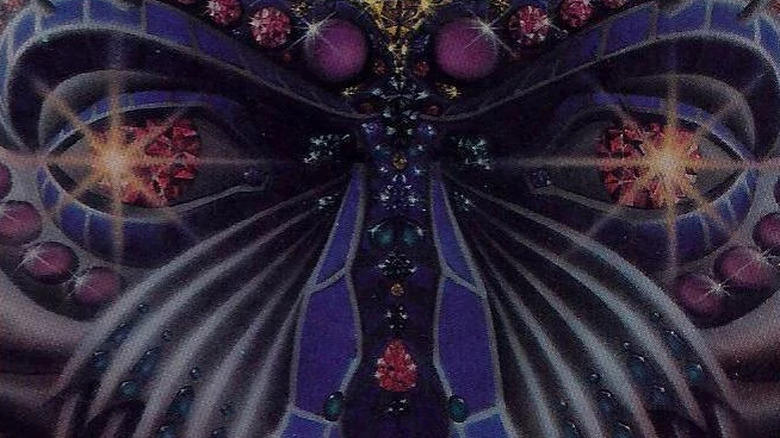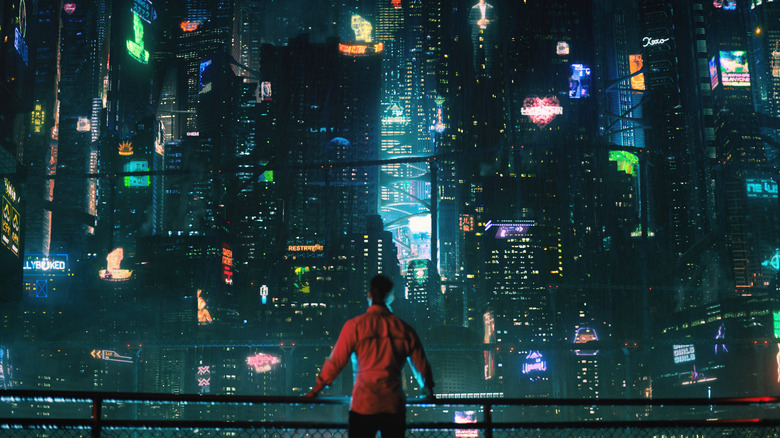Forget The Matrix, Let The Long-Awaited Neuromancer Adaptation Reboot Cyberpunk
Neon cityscapes. Cybernetic augmentations. Puppet governments run by global megacorporations. These are just some of the many, many tropes that define the cyberpunk genre. Though it's never been quite as popular as more traditional science fiction, cyberpunk has been a staple of the larger genre for decades, largely thanks to seminal works like "Blade Runner," "Ghost in the Shell," and of course, William Gibson's "Neuromancer."
Published in 1984, just two years after "Blade Runner" made its mark on the film industry, "Neuromancer" is considered by many to be the definitive piece of cyberpunk fiction. Most of the defining traits and aesthetics of the genre can be traced back to Gibson's novel, which follows a down-and-out hacker named Case and a "street samurai" named Molly as they get pulled down a twisty rabbit hole of corporate hacking, government secrets, and dangerous AI. And yet, these days, "Neuromancer" has largely faded from the public consciousness.
There's a simple explanation for that: Movies and TV shows dominate pop culture today, and "Neuromancer" has never been adapted into either. The cyberpunk genre has seen something of a resurgence in recent years, with "Blade Runner" getting a sequel in 2017 and CD Projekt Red's "Cyberpunk 2077" becoming one of the biggest video game releases of all time. Numerous other modern projects across media have embraced the deliciously cliché style of cyberpunk, and franchises like "The Matrix" have helped redefine the genre. But for cyberpunk to truly return to the top where it belongs, we need a proper "Neuromancer" adaptation.
Neuromancer is the main reason cyberpunk exists
Because "Blade Runner" is so beloved, and because it came out two years before "Neuromancer," it's easy to assume that Gibson's novel is more of a rip-off than the genesis of cyberpunk. The truth, however, is a little more complicated. Gibson had been writing cyberpunk short stories and publishing them in sci-fi magazines for years before "Blade Runner" was released. These stories included 1981's "Johnny Mnemonic," which was later adapted for the big screen with Keanu Reeves in the leading role, and 1982's "Burning Chrome," which takes place in the same continuity as "Neuromancer."
In these earlier stories, Gibson had already laid out the core tenets of his particular sci-fi vision. The style and tone borrow heavily from film noir and classic hardboiled crime novels. Thematically, the stories deal with the intersections of humanity and evolving technology, from cybernetic augmentations to the mass commercialization of life. Gibson envisioned a world where urban sprawl dominated the planet, where shadowy corporations and cult-like populist groups struggled over ideology and resources, and where the residue of the Cold War lay heavy on everyone and everything.
"Blade Runner" incorporated many of these same ideas — the polluted metropolis, neon skylines, and noir stylings, for instance — in a visual medium that gave cyberpunk a true face. The ideas of Ridley Scott's film, however, are more rooted in the classical science fiction of the 1960s, which makes sense given that it's an adaptation of Philip K. Dick's "Do Androids Dream of Electric Sheep?" (1968). "Neuromancer" is far more interested in the cyber world. Gibson's writing is quite literally the reason that "cyberspace" became a common phrase.
Classical cyberpunk like Neuromancer has become more popular in recent years
"Neuromancer" and "Blade Runner" are both seminal texts, and they were popular in their day as well. Despite that, cyberpunk has generally been a niche genre since its inception in the late '70s and early '80s. "The Matrix" is arguably the biggest franchise to embrace cyberpunk aesthetics, but it isn't really a part of the genre thematically. Where Gibson's work and other traditional cyberpunk stories are interested in corporate authoritarianism and cybernetics, "The Matrix" is more philosophical and concerned with malicious AI. They intersect for sure, but only the first "Matrix" really fits within the genre.
Cyberpunk thrived in the early years with comics like "Judge Dredd" and "Ronin" and manga like "Akira," many of which were later adapted for the screen. But after a while, the genre faded into a niche that seldom saw the pop culture spotlight.
Recently, though, that's started to change. "Blade Runner 2049," "Cyberpunk 2077," "Cyberpunk: Edgerunners," and Netflix's "Altered Carbon" adaptation are just some of the big releases in the genre over the past several years. People know what cyberpunk is again, and it's regained a lot of ground in the sci-fi community. Now is the time for a proper revival. Now is the time for the "Neuromancer" adaptation fans of the book have long demanded.
The complicated history of Neuromancer adaptations
To be fair, many people have tried and failed to adapt "Neuromancer" in the past. In the early 2000s, music video director Chris Cunningham was attached to helm a film version with the explicit approval of William Gibson. However, the script ran into a number of problems and development stalled. In 2007, another version surfaced from director Joseph Kahn, with Milla Jovovich eyed for the role of Molly. Then it was "Cube" director Vincenzo Natali, with a film version supposedly involving Mark Wahlberg and Liam Neeson. That project lingered for years before fizzling, only to be replaced by rumors that Tim Miller and Simon Kinberg were heading up the adaptation in 2017.
The latest rumor came out of The Illuminerdi in November 2022, claiming that Miles Teller was set to star in a "Neuromancer" series on Apple TV+. That report has yet to be officially confirmed, and given the troubled history of the "Neuromancer" adaptation, it may not come to fruition even if it proves to be true.
"Neuromancer" could still work as a theatrical release, but a TV series might make more sense given the density of the story and the past problems with movie versions. These days, prestige streaming shows are arguably the biggest properties in Hollywood, and Gibson's world could be brought to life beautifully if adapted in the right way.
What a modern Neuromancer adaptation could look like
Though the project has struggled for decades to get off the ground, there may never have been a better time than now to adapt "Neuromancer" for the screen. Modern audiences have been reintroduced to the tropes, language, and aesthetics of cyberpunk, and streaming is the perfect venue to fully explore Gibson's dark neon world.
Geographically, "Neuromancer" covers a lot of ground. The story begins in a section of Japan's Chiba City referred to colloquially as "Night City" (for any "Cyberpunk 2077" fans out there), which introduces a lot of the visual style of the genre. But Case and Molly voyage far beyond that starting point, journeying through the industrial megapolis that engulfs much of North America, flashbacks to the last global war, and even outer space. It's a lot of material, which is why a serialized adaptation might work better than the big screen.
It's also worth noting that "Neuromancer" is technically part of a series known as the Sprawl Trilogy. If a show were to catch on, it could also eventually adapt 1986's "Count Zero" and 1988's "Mona Lisa Overdrive." Though it's coming up on its 40-year anniversary, "Neuromancer" is just as relevant now as it was in 1984. Its cautionary vision of a global corporate takeover, cyberized culture, and ecological collapse is frighteningly contemporary, and it has all the twists and turns needed to keep viewers on the edge of their seats.
